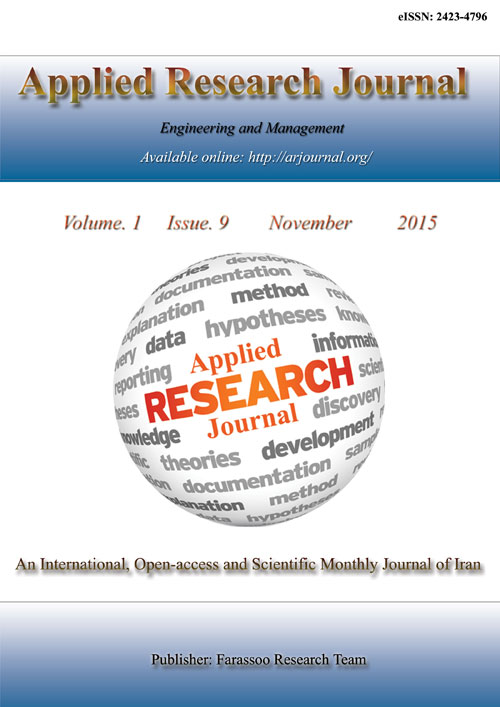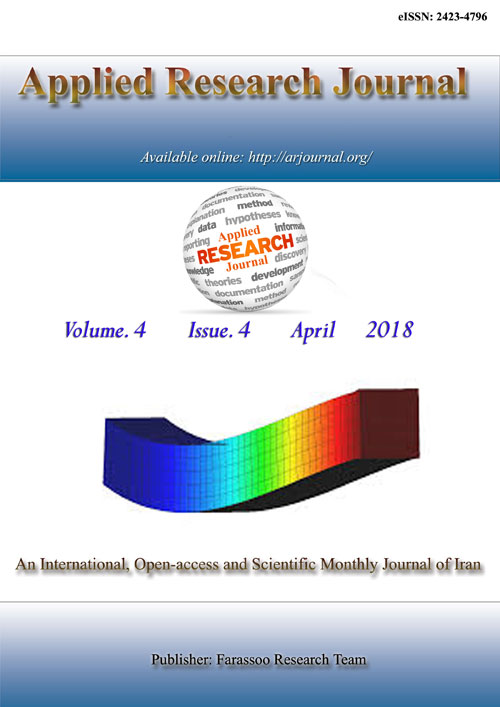فهرست مطالب

Applied Research Journal
Volume:1 Issue: 9, Nov 2015
- تاریخ انتشار: 1394/09/10
- تعداد عناوین: 5
-
Page 451Neem tree samples (Azadirachta indica) were collected from Maiduguri metropolis, Borno State, Nigeria for the determination of trace elements. The concentrations of metals were observed lowest from the control sites. Concentrations of Pb, Zn, Mn and Fe were found to be highest from samples obtained at the Borno express motor park; Cr and Cd highest at West end junction; Ni highest at University gate while Polo road showed the lowest concentrations of all the metals. This deviation could be due to the volumeof vehicular movement in the afore-mentioned sampling points. However, the levels of the metals in the samples exceeded the World Health Organisation standard limits for medicinal plants. The traffic situation in the area of study might be regarded as a source of the variation in the metal concentration between the control sites and the four sampling points.Keywords: Trace element, Concentration, Sampling points, Control sites, Neurophysiologic
-
Page 455carbon monoxide gases as feedstock in the Fischer-Tropsch reactions. Ratio of hydrogen to carbon monoxide input to feed in Fischer-Tropsch reaction is very important for the production of valuable products such as ethylene, propylene and combustible materials. As a result, there is high demand for these materials in order to develop new technologies with lower costs. Thermodynamic modeling of H2 and CO produced in the reforming reaction (CH4/H2O=2/3) has been carried out by Gibbs free energy minimization at the temperatures range of 500-1500˚K and pressures of 1-20atm. The results showed that at different pressures and at high temperatures (1000-1500˚K)production of hydrogen and carbon monoxide increases and the ratio of H2/CO reaches to desired value. At temperatures higher than 1200˚K and in all pressure ranges (1-20atm), the ratio of H2/CO values will be fixed and increasing pressure will not have much impact on the value of this ratio. Favorable conditions to determine the optimal ratio of H2/CO for the Fischer-Tropsch reaction and more production of hydrogen and carbon monoxide gases were obtained at the temperature range of 1000-1200˚K and low pressure (1atm).Keywords: Fischer, Tropsch, synthesis gas, steam, methane reforming, Gibbs free energy minimization method
-
Page 460The present study was conducted to assess the performance of HMA modified by styrene-butadiene-rubber (SBR) and polystyrene (PS) polymers. Four different ratios; namely 1, 3, 5, and 7% of each polymer by weight of asphalt were blended with 40/50 paving grade asphalt. Both unmodified and modified asphalt binders were subjected to rheological and homogeneity tests such as penetration, ductility, softening point, percentloss of heat and air, and temperature susceptibility. The performance tests including, Marshall stability, Marshall quotient (MQ), tensile strength, compressive strength, and flexural strength. The results show that the performance of SBR and PS modified asphalt mixtures are superior than conventional mixtures. The moisture susceptibility and temperature susceptibility can be reduced by the implication of SBR and PS polymers inthe asphalt mixture. A polymer content of 5% for SBR and 5% for PS by weight of asphalt are recommended for the improvement of HMA performance.Keywords: Asphalt Binder, Asphalt Mixture, Asphalt Modifiers, Polymers, Polystyrene, Styrene, Butadiene, Rubber
-
Page 470The Phytochemical constituents in aqueous and leaf extracts of Moringa oleifera Lam were assessed and compared with the literature reports and proximate analysis for food nutrients using smart spectrophotometric method. The results of the qualitative Phytochemical screening showed the presence of the tested phytochemical properties (saponin, tannin, alkaloid, and flavonoids) and the proximate analysis revealed the nutrients levels as moisture (15.8067%), ash (9.2568%), fat (1.2950%), protein (19.95%) and carbohydrate (53.6915%). The results from this study confirmed the notionbehind the extensive use of the leaves of this plant in ethanomedicine and its potentials in drug formulations.Keywords: Proximate, Medicinal, Bark, Phytochemicals, Folk Medicine
-
Page 473The extraction and characterization of both crude and refined of Moringa oleifera oil found in North East Ecological Zone of Nigeria has been carried out. Normal hexane was used as solvent for the extraction process. The oil produced was refined through transesterification process using methoxide and magnetic stirrer local. The characterization analysis revealed that tested parameters, which include specific gravity, refractive index, viscosity, density, acid value, saponification value and iodine value for both crude and refined Moringa oil produced, were within the ASTM standardspecifications. The oil was analysed using Gas Chromatography Mass Spectrometer method showing the composition and components of the oil. The major component obtained is Octadecenoic acid having highest abundance with respect to retention time as displayed by the highest peaks in the graphs.The oil is of good quality and could be recommended suitable for industrial usage.Keywords: Moringa oliefera, biodiesel, solvent extraction, Transestarification, Gas Chromatography, Mass Spectrometer


